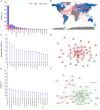A bibliometric profile of optogenetics: quantitative and qualitative analyses
- PMID: 37424998
- PMCID: PMC10323434
- DOI: 10.3389/fnins.2023.1221316
A bibliometric profile of optogenetics: quantitative and qualitative analyses
Erratum in
-
Corrigendum: A bibliometric profile of optogenetics: quantitative and qualitative analyses.Front Neurosci. 2023 Jul 27;17:1258856. doi: 10.3389/fnins.2023.1258856. eCollection 2023. Front Neurosci. 2023. PMID: 37575307 Free PMC article.
Abstract
Introduction: Optogenetics is a rapidly developing field combining optics and genetics, with promising applications in neuroscience and beyond. However, there is currently a lack of bibliometric analyses examining publications in this area.
Method: Publications on optogenetics were gathered from the Web of Science Core Collection Database. A quantitative analysis was conducted to gain insights into the annual scientific output, and distribution of authors, journals, subject categories, countries, and institutions. Additionally, qualitative analysis, such as co-occurrence network analysis, thematic analysis, and theme evolution, were performed to identify the main areas and trends of optogenetics articles.
Results: A total of 6,824 publications were included for analysis. The number of articles has rapidly grown since 2010, with an annual growth rate of 52.82%. Deisseroth K, Boyden ES, and Hegemann P were the most prolific contributors to the field. The United States contributed the most articles (3,051 articles), followed by China (623 articles). A majority of optogenetics-related articles are published in high-quality journals, including NATURE, SCIENCE, and CELL. These articles mainly belong to four subjects: neurosciences, biochemistry and molecular biology, neuroimaging, and materials science. Co-occurrence keyword network analysis identified three clusters: optogenetic components and techniques, optogenetics and neural circuitry, optogenetics and disease.
Conclusion: The results suggest that optogenetics research is flourishing, focusing on optogenetic techniques and their applications in neural circuitry exploration and disease intervention. Optogenetics is expected to remain a hot topic in various fields in the future.
Keywords: bibliometrics; hot topic; optogenetics; qualitative analysis; quantitative analysis.
Copyright © 2023 Zhou, Wang, Li and Liao.
Conflict of interest statement
The authors declare that the research was conducted in the absence of any commercial or financial relationships that could be construed as a potential conflict of interest.
Figures






Similar articles
-
Research Trends in the Application of Artificial Intelligence in Oncology: A Bibliometric and Network Visualization Study.Front Biosci (Landmark Ed). 2022 Aug 31;27(9):254. doi: 10.31083/j.fbl2709254. Front Biosci (Landmark Ed). 2022. PMID: 36224012
-
Knowledge domain and hotspots concerning photosensitive hydrogels for tissue engineering applications: A bibliometric and visualized analysis (1996-2022).Front Bioeng Biotechnol. 2022 Nov 14;10:1067111. doi: 10.3389/fbioe.2022.1067111. eCollection 2022. Front Bioeng Biotechnol. 2022. PMID: 36466359 Free PMC article.
-
Research focus and thematic trends in magnet hospital research: A bibliometric analysis of the global publications.J Adv Nurs. 2021 Apr;77(4):2012-2025. doi: 10.1111/jan.14757. Epub 2021 Jan 15. J Adv Nurs. 2021. PMID: 33450072 Review.
-
Research trends in the field of the gut-brain interaction: Functional dyspepsia in the spotlight - An integrated bibliometric and science mapping approach.Front Neurosci. 2023 Mar 8;17:1109510. doi: 10.3389/fnins.2023.1109510. eCollection 2023. Front Neurosci. 2023. PMID: 36968499 Free PMC article. Review.
-
A bibliometric analysis of diffuse large B-cell lymphoma research from 2001 to 2020.Comput Biol Med. 2022 Jul;146:105565. doi: 10.1016/j.compbiomed.2022.105565. Epub 2022 Apr 29. Comput Biol Med. 2022. PMID: 35594683 Review.
References
-
- Aria M., Cuccurullo C. (2017). bibliometrix: an R-tool for comprehensive science mapping analysis. J. Informet. 11, 959–975. doi: 10.1016/j.joi.2017.08.007 - DOI
LinkOut - more resources
Full Text Sources

